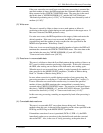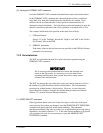
C141-C013 389
CHAPTER 7 Disk Media Management
7.1 Defect Management
7.2 Disk Media Initialization
7.3 Alternate Block Allocation Processing
7.4 Background Media Scan (BMS)
7.5 Drive Self-Test (DST)
7.6 SMART (Self-Monitoring Analysis and Reporting Technology)
In this chapter, disk media defect management methods, treatment methods for
media defects which occur during operation, reinitialization procedures and other
disk media management methods are discussed. Furthermore, see Chapter 3,
"Data Format" in the "Product Manual" concerning details of the data recording
format on the disk media.
7.1 Defect Management
(1) Defect lists
Information on the positions of defects in the disk media is managed by the types
of defect list shown below. See the description of the FORMAT UNIT command
(Section 4.3.1) concerning methods for using the defect lists.
• P List Defect position information at the point when the disk drive was
shipped from the factory is recorded in this list. The defective
portions included in this list are permanent defects, and when the disk
media is initialized, it is necessary that this list is used and alternate
block processing is executed.
• D List This list includes defect position information specified by the INIT in
the FORMAT UNIT command when initializing the disk media.
• G List This list is composed from the defective logical data block position
information specified by the INIT in the REASSIGN BLOCKS
command, defective logical data block position information from
alternate blocks which have been allocated by the HDD's auto
alternate block allocation processing, information specified as the D
List and information generated as the C List.
The P List and G List are recorded in the system space on the disk media. The
INIT can read the contents of these lists by the READ DEFECT DATA command.


















